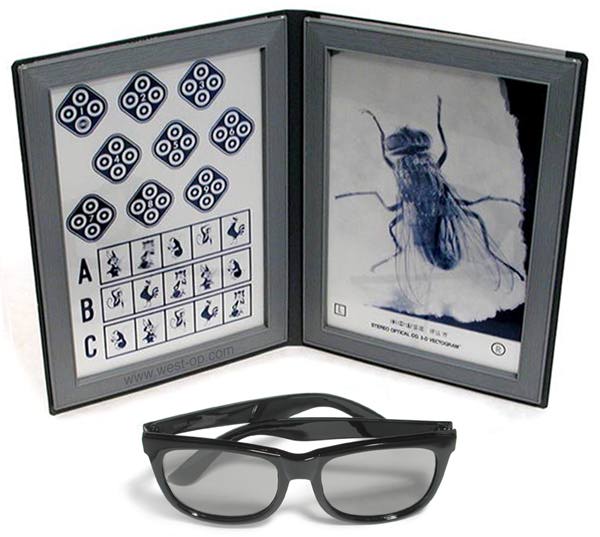What is a Vectogram?
A vectograph is a type of stereoscopic print or transparency viewed by using polarized 3D glasses. When viewed through these polarizing filters it presents one image to one eye and another image to the other eye. Vectographs are often referred to as Vectograms in optometry because "Vectogram" is the registered trademark name given to one of the products used for optometric purposes (1).
Vectograms in Optometry
One of the most common vectographs is the Titmus Fly Stereotest, a greatly enlarged stereoscopic image of a fly used by optometrists and ophthalmologists to determine if patients, especially young children, have normal stereoscopic vision (1). Stereo depth-perception tests, such as the Stereo Fly, have proven to be an effective and easy-to-use method of screening vision for all ages. They help to identify vision problems and conduct analysis of stereopsis, lazy eye (amblyopia), suppression, and strabismus, each of which can impede a child’s development and performance. The Stereo Fly test allows optometrists and ophthalmologists to evaluate both gross and fine stereo vision (2).

Vectograms in Vision Therapy
As a vision therapy tool, Vectograms are used to improve visual skills and to use your eyes together as a unit or a team. When viewed through polarizing filters it presents one image to one eye and another image to the other eye.

Vectograms stabilize fusion and stereopsis and also eliminate and control suppression and fixation disparity. They are available in fixed or variable styles to accommodate unlimited base-in and base-out training. In vision therapy, vectograms help the patient learn to use their eyes to converge (look close) or diverge (look far). It is a good way to help make patients aware of their role in the visual process and gain control of certain visual skills.
The visual skills mastered through vision therapy will assist a patient to maintain fixation for longer periods of time while reading, doing work on a computer or copying from a whiteboard to paper in school.
History of the Vectogram
Credit for the concept of the vectograph is due to Joseph Mahler, cousin of famed composer and conductor Gustav Mahler. He immigrated to the U.S. from Czechoslovakia in 1938 and was hired by the Polaroid Corporation, where he worked with its founder, inventor Edwin Land, to develop his idea into a practical process (1).
References
The Vision Wiki
- Lazy Eye Treatments
- Optometric Vision Therapy
- Eye Exercises
- Pencil Pushups
- Brock String
- Vision Therapy
- Sports Vision
- Virtual Reality
- Red Green Glasses
- Vision Therapy for Adults
- Vision Therapy Apps
- Vectograms
- Eye Drops for Amblyopia
- Strabismus Surgery
- Eye Patching
- Prism Glasses
- Dichoptic Training
- Binasal Occlusion
- Eye Problems
- Binocular Vision
- Physiology of Vision
- Lazy Eye
- Reading
- Fields of Study
- Research
- Glaucoma
- Virtual Reality
- Organizations
